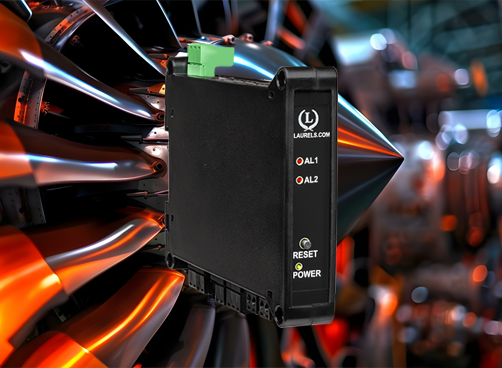
Features
- Factory calibrated for thermocouple types J, K, T, E, N, R, S
- Accuracy ±0.01% of full span ± conformity error
- Entire range of each thermocouple in one scale
- User selectable input span from entire thermocouple range down to 15.0°
- Selectable 1° or 0.°1, degrees Celsius, Fahrenheit, Kelvin or Rankin
- All input ranges are user selectable and factory calibrated
- Up to 60 conversions per second, Ideal for peak or valley capture
- 4-20 mA, 0-20 mA, 0-10V or -10V to +10V transmitter output, (isolated)
- Analog output resolution 0.0015% of span, accuracy ±0.02% of span
- Ethernet data I/O, Modbus TCP
- Dual 120 mA solid state relays for alarm or control (isolated)
- Power 85-264 Vac / 90-300 Vdc or 10-48 Vdc / 12-32 Vac (isolated)
- DIN rail mount housing, 22.5 mm wide, detachable screw-clamp connectors
- Operating temperature from -40°C to 70°C (-40°F to 158°F)
The Laureate™ LTE Series DIN rail analog transmitter with ethernet communication and analog outputs for versatile connectivity.
The digitally programmable transmitter features two relays for alarm or control. The series offers exceptional accuracy of 0.01% of reading ± 2 counts, with high read rates at up to 60 or 50 conversions per second. The LTE Series transmitters offer the same high performance, signal conditioning, and programmable features as Laureate digital panel meters, counters, and timers.The Laureate 4-20 mA, 0-20 mA, 0-10V or -10V to +10V and ethernet output transmitter for thermocouple input signal offers the same high performance, signal conditioning, and programmable features as Laureate digital panel meters, counters, and timers. It provides six voltage input ranges and four current input ranges, all factory calibrated and jumper selectable. This thermocouple transmitter delivers a linearized, highly accurate, stable, and repeatable output for thermocouple types J, K, T, E, N, R, or S. The thermocouple type and temperature range, specified in °C or °F, are user-selectable. The temperature range can be as wide as the entire span of the thermocouple type, or as narrow as 150 counts (such as 15.0°), limited only by considerations of electrical noise and digital filtering time constants.
All ranges for all thermocouple types are factory-calibrated, with calibration factors stored in EEPROM on the signal conditioner board. This allows temperatures sensors and signal conditioner boards to be changed in the field without recalibrating the transmitter. Factory recalibration is recommended every 12 months. For cold junction compensation (CJC), an external transistor is mounted adjacent to the thermocouple input to measure ambient temperature. That transistor is calibrated as a system with the signal conditioner board. All Laurel Electronics instruments undergo factory calibration using the industry-leading Fluke calibrators, which are recalibrated yearly and certified traceable to national standards, ensuring the highest level of precision and reliability.
Laureate Transmitters are easily programmed with Laurel’s free Instrument Setup Software, downloadable from our website and compatible with Windows PCs, requiring a data interface board for setup.
High read rate of up to 50 or 60 conversions per second, the Laureate™ LTE Series transmitter uses Concurrent Slope (US Pat. 5,262,780) analog-to-digital conversion to integrate signals over a full power line cycle (50 Hz or 60 Hz). This read rate enables peak and valley capture, real-time computer interfacing, and control applications. Peak and valley values are automatically captured and can be viewed using Laurel’s free Instrument Setup Software (compatible with Windows PCs) or transmitted as serial data.
Standard Features of Laureate LTE Transmitters Include:
- Ethernet I/O, (isolated). The supported protocols are Modbus RTU and ASCII, which are tunneled via Modbus TCP. Note that RS232 or RS485 data I/O is provided by Laurel's LT Series transmitters.
- 4-20 mA, 0-20 mA or 0-10V analog transmitter output, (isolated), jumper-selectable and user scalable. All selections provide 16-bit (0.0015 ) resolution of output span and 0.02% output accuracy of a reading from -99,999 to +99,999 counts that is also transmitted digitally. Output isolation from signal and power grounds eliminates potential ground loop problems. The supply can drive 20 mA into a 500 ohm (or lower) load for 10V compliance, or 10V into a 5K ohm (or higher) load for 2 mA compliance.
- Dual solid state relays, (isolated). Available for local alarm or control. Rated 120 mA at 130 Vac or 180 Vdc.
- Selectable transducer excitation output, (isolated), user selectable 5V@100 mA, 10V@120 mA, 12V@100 mA, or 24V@50 mA.
- Power 85-264 Vac, (isolated), low-voltage 10-48 Vdc or 12-32 Vac power is optional.
Digital signal filtering modes can be selected to ensure stable readings in electrically noisy environments.
- An unfiltered selection provides true peak and valley readings and aids in control applications.
- A batch average filter selection averages each 16 conversions.
- Dual solid state relays for control or alarm, (isolated). Rated 120 mA at 140 Vac or 180 Vdc. The relays can respond to digital readings or to received control characters.
- An adaptive moving average filter selection provides a choice of 8 time constants from 80 ms to 9.6 s. When a significant change in signal level occurs, the filter adapts by briefly switching to the shortest time to follow the change, then reverts back to its selected time constant. An auto setting selects the time constant selection based on signal noise.
Two tare functions: auto-tare and manual tare. In auto-tare, an input line is grounded by an external pushbutton. This causes the current weight, which is normally the empty weight of the container to be stored in memory as an offset. In manual tare, the tare value can be entered manually via a control input pushbutton or using Laurel's free Instrument Setup Software.
Peak and valley values are automatically captured. These may be displayed via Laurel's free Instrument Setup Software, which runs on a PC under MS Windows or can be transmitted as serial data.

LTE series DIN rail transmitters & signal conditioners can be interfaced to a wide range of sensors and transducers using one of seven available plug-in signal conditioner boards. The transmitters duplicate the high performance (high accuracy, high read rate) and extensive programmable features of Laureate 1/8 DIN digital panel meters, counters and timers. They utilize the same signal conditioners boards, much of the same firmware, and Laurel's free Windows-based Instrument Setup Software. They come in a compact DIN rail mount package with detachable screw-clamp connectors for easy wiring.
The LTE series Transmitters accessible from this page include a 4-20 mA, 0-20 mA, 0-10V, or -10V to +10V analog output (isolated, user selectable), an ethernet serial data interface (isolated, user selectable), and dual 120 mA solid state AC/DC relays (isolated). An (isolated) 5, 10, 12, or 24 Vdc transducer excitation output is included with all models other than those with a temperature or AC RMS signal conditioner.
Connecting Laureate LTE Transmitters to a Local Area Network (LAN)
Laurel LTE series Ethernet transmitters can connect directly to a LAN via an Ethernet cable. Up to 30 Laureate LT Transmitters and/or Digital Panel Meters can be configured for RS485 and daisy-chained to an LT Transmitter for seamless LAN integration. Setup for both configurations is streamlined using Laurel’s free Instrument Setup Software, which simplifies node discovery and transmitter configuration.
Flexible Communication Options for LTE Transmitters
Laureate Transmitters can be equipped with Laurel communication boards to support various interfaces and protocols. These include serial interfaces with ASCII or Modbus RTU protocols, and Ethernet interfaces with web access, ASCII, or Modbus TCP/IP protocols, ensuring versatile connectivity for your commercial applications.
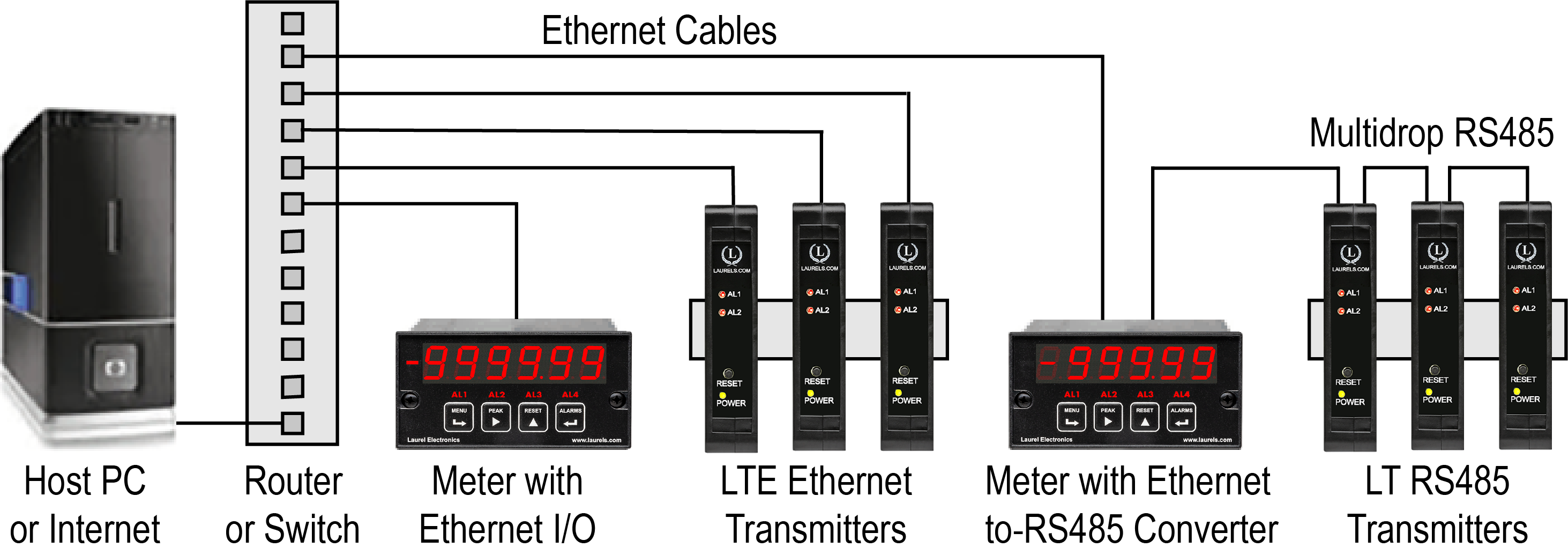
| LTE Transmitter Signal Input & Function | Model Series | Analog Output | Ethernet I/O | Dual Relays | |
|---|---|---|---|---|---|
| 1 | DC Input Voltage and Current | LTE-DC |  |
 |
 |
| 2 | AC RMS Voltage or Current | LTE-RMS |  |
 |
 |
| 3 | Process Voltage or Current | LTE-P |  |
 |
 |
| 4 | Strain Gauge or Potentiometer Follower | LTE-SG |  |
 |
 |
| 5 | Weighing Applications | LTE-WA |  |
 |
 |
| 6 | Load Cell & Microvolt Signals | LTE-WM |  |
 |
 |
| 7 | Thermocouple (Types J, K, T, E, N, R, S) | LTE-TC |  |
 |
 |
| 8 | RTD Temperature | LTE-RTD |  |
 |
 |
| 9 | Resistance in Ohms | LTE-R |  |
 |
 |
| 10 | Frequency, Rate, Speed | LTE-FR |  |
 |
 |
| 11 | Pulse Input Totalizer | LTE-FR |  |
 |
 |
| 12 | Process Signal Totalizer | LTE-VF |  |
 |
 |
| 13 | Batch Controller Analog Input | LTE-FR |  |
 |
 |
| 14 | Batch Controller Pulse Input | LTE-FR |  |
 |
 |
| 15 | Sum, Difference, Ratio, Product of 2 Inputs | LTE-FR |  |
 |
 |
| 16 | On/Off Duty Cycle | LTE-FR |  |
 |
 |
| 17 | Stopwatch Timing for Single Events | LTE-FR |  |
 |
 |
| 18 | Average Time of Periodic Events | LTE-FR |  |
 |
 |
| 19 | AC Phase Angle and Power Factor | LTE-FR |  |
 |
 |
| 20 | Quadrature Position or Rate | LTE-QD |  |
 |
 |
Laureate Ethernet & 4-20 mA Output Thermocouple Temperature Transmitter
| TC Types | Range | Conformity Error | ||
|---|---|---|---|---|
| J | -210°C to +760°C (-347°F to +1400°F) | ±0.09°C (±0.16°F) | ||
| K | -244°C to +1372°C (-408°F to +2501°F) | ±0.1°C (±0.17°F) | ||
| L | 0°C to +400°C (32°F to 752°F) -257°C to 0°C (-430°F to +32°F) |
±0.03°C (±0.05°F) ±0.2°C (±0.36°F) |
||
| E | -240°C to +1000°C (-400°F to +1830°F) | ±0.18°C (±0.32°F) | ||
| N | -245°C to +1300°C (-410°F to +2370°F) | ±0.10°C (±0.17°F) | ||
| R | -45°C to +1768°C (-49°F to +3214°F) | ±0.17°C (±0.31°F) | ||
| S | -46°C to +1768°C (-51°F to +3213°F) | ±0.12°C (±0.22°F) | ||
| Recalibration: All ranges are calibrated at the factory. Recalibration is recommended every 12 months. | ||||
| Analog Input | ||||
|---|---|---|---|---|
| Calibration | NIST Monograph 125 (IPTS-68) | |||
| Input Resistance | 1 GΩ | |||
| Input Current | 100 pA | |||
| Max Lead Resistance | 1 kΩ max for rated accuracy | |||
| Overall Error at 25°C | ±0.01 of full scale ±2 counts | |||
| Span Tempco | ±0.003% of reading/°C | |||
| Ref Junction Tempco | ±0.02 deg/deg | |||
| Overvoltage Protection | 125 Vac | |||
| NMR at 50/60 Hz | 80 dB plus selectable filter from 80 ms to 9.6 s time constant | |||
| CMR, DC-60 Hz | 120 dB with 500Ω imbalance | |||
| CMV, DC-60 Hz | 250 Vac from power and earth grounds | |||
| Open Sensor Indication | 0 mA or > 20 mA output, selectable | |||
| Analog Output (standard) | ||||
| Output Levels | 4-20 mA, 0-20 mA, 0-10 Vdc (jumper selectable) | |||
| Compliance, 4-20 mA | 10V (0-500Ω load) | |||
| Compliance, 0-10V | 2 mA (5 kΩ load or higher) | |||
| Output Resolution | 16 bits (65,536 steps) | |||
| Output Error | ±0.02% of output span ± overall input error | |||
| Output Isolation | 250V rms working, 2.3 kV rms per 1 minute test | |||
| Step Response Time | 50 ms | |||
| Ethernet Data I/O (standard) | ||||
| Type | 10/100 Base-T Ethernet per IEEE 802.3 | |||
| Data Rates | 300, 600, 1200, 2400, 4800, 9600, 19200 baud | |||
| Output Isolation | 250V rms working, 2.3 kV rms per 1 min test | |||
| Serial Protocol | Modbus TCP | |||
| Modbus Compliance | Modbus over Serial Line Specification V1.0 (2002) | |||
| Digital Addresses | 247 | |||
| Dual Relay Output (standard) | ||||
| Relay Type | Two solid state relays, SPST, normally open, Form A | |||
| Load Rating | 120 mA at 140 Vac or 180 Vdc | |||
| Power Input | ||||
| Standard Power | 85-264 Vac or 90-300 Vdc | |||
| Low Power Option | 10-48 Vdc or 12-32 Vac | |||
| Power Frequency | DC or 47-63 Hz | |||
| Power Isolation | 250V rms working, 2.3 kV rms per 1 min test | |||
| Power Consumption | 2.5W typical at 24V | |||
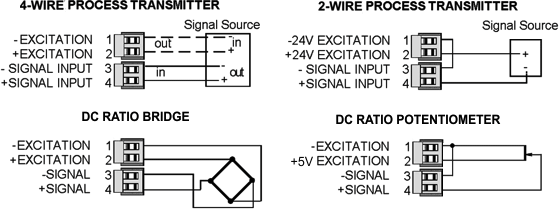 |
||||
| Environmental | ||||
| Operating Temperature | -40°C to 70°C (-40°F to 158°F) | |||
| Storage Temperature | -40°C to 85°C (-40°F to 185°F) | |||
| Relative Humidity | 95% at 40°C, non-condensing | |||
| Cooling Required | Mount transmitters with ventilation holes at top and bottom. Leave 6 mm (1/4") between transmitters, or force air with a fan. | |||
| Mechanical | ||||
| Enclosure | Rugged black polycarbonate housing material | |||
| Mounting | 35 mm rail per DIN EN 50022 | |||
| Dimensions | 129 x 104 x 22.5 mm case | |||
| Connectors | Detachable screw clamp connectors meet VDE / IEC / UL / CSA standards. RJ45 jack for Ethernet | |||
| Tightening Torque | Screw terminal connectors: 5 lb-in (0.56 Nm) | |||
| Weight | Complete transmitter: 183 g (6.5 oz) | |||
| General | ||||
| Programming | Utilize Laurel's free Instrument Setup Software, which runs on a PC under MS Windows. | |||
| Security | Lockout options available using Laurel's free Instrument Setup Software. | |||
| Warranty | 3 years parts & labor | |||
| Recalibration: All ranges are calibrated at the factory. Recalibration is recommended every 12 months. | ||||
Transmitter Pinout
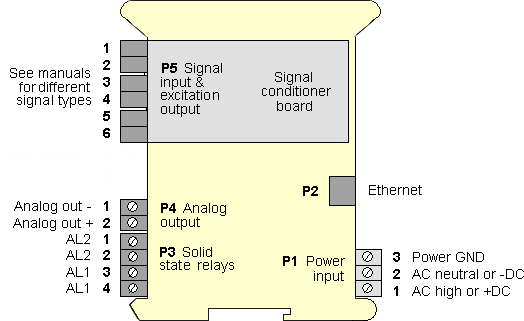
Operation as a Fast ON/OFF Controller or Supervisory Monitor
 With the optional dual solid state relay output option, which has a typical response time of only 17 ms, Laureate temperature meters and transmitters can serve as extremely fast and accurate ON/OFF controllers for closed-loop temperature control. They can also serve as supervisory process monitors and provide alarms or shutoffs when processes exceed normal limits.
With the optional dual solid state relay output option, which has a typical response time of only 17 ms, Laureate temperature meters and transmitters can serve as extremely fast and accurate ON/OFF controllers for closed-loop temperature control. They can also serve as supervisory process monitors and provide alarms or shutoffs when processes exceed normal limits.
Multiple setpoint operating modes are individually selectable for each relay, as explained in the dual-setpoint controller page. Relay duty cycles and chatter can be minimized with programmable hysteresis and time delays. A band deviation operating mode can be selected for each relay, where an alarm is generated whenever the reading is a selected number of counts above or below the setpoint. The relay modes have to be non-latching, since 4-20 mA temperature transmitters do not offer external reset.
Free Instrument Setup Software for Series 2 Laureates
Free Downloadable Windows-based Instrument Setup (IS) software (Data Interface Board Required) for use with our programmable Digital Panel Meters, Scale Meters, Counters, Timers, Remote Displays, and Transmitters, are an easy method to set up Laureate 1/8 DIN digital panel meters, counters, timers, remote displays, and DIN-rail transmitters, as explained in the Instrument Setup Software Manual. Laureate 1/8 DIN instruments can also be set up from the front panel, as explained in their respective Owners Manuals. Instrument Setup software is of benefit whether or not the PC is connected to the instrument.
- When the PC is connected to the instrument, Instrument Setup software can retrieve the setup file from the instrument or open a default setup file or previously saved setup file from disk View Setup, then provides graphical user interface (GUI) screens with pull-down menus applicable to input, display, scaling, filtering, alarms, communications, analog output, and front panel lockouts. Fields that are not applicable to the instrument as configured are either left out or grayed out. Clicking on any item will bring up a detailed Help screen for that item. After editing, the setup file can be downloaded, uploaded to the instrument, or saved to a disk. The same setup file can then be downloaded into multiple instruments.
- When the PC is not connected to the instrument, the above GUI screens can be used to set up a virtual instrument. The setup file can then be saved to disk. Switching toView Menu then brings up a screen with the required front panel programming steps. This view can be printed out for use at the instrument site and to serve as a hard copy record.
Download Free Instrument Setup Software
Installation
Set User Account Control (UAC) of MS Windows to "Never notifiy me" so that Instrument Setup Software can create directories. The UAC change screen can be reached as follows:
- Under Windows 7, click on the Windows Start button in the lower left of the desktop and enter "UAC" in the search field.
- Under Windows 8, navigate to Control Panel, then to the "User Accounts and Family Safety" section, and click on "Change User Account Control Settings."
- Under Windows 10, click on the Windows Start button in the lower left of the desktop, then on "Settings", and enter "UAC" in the search field.
- Reboot your computer for the changed UAC setting to take effect.

RJ11-to-DB9 cable with rear view of DB9 connector to PC

RS232 cable, meter to PC, P/N CBL01
Laureate 1/8 DIN Laureate instruments must be equipped with a serial communications board and be connected to the computer via a serial communications cable. The connection can be via RS232, RS485, USB or Ethernet. Following setup, the serial communications board may be removed from the instrument if desired. The wiring of the RS232 cable is illustrated above with end views of the two connectors.
Laureate LT Series transmitters come standard with a 3-wire serial interface, which can be jumpered for RS232 or RS485.
Laureate LTE Series transmitters come standard with an Ethernet interface.
Meter Setup Screens
Click on any of the reduced screens below for a full-size screen view, then click on the Back button of your browser to return to this page. The screens examples below are for a fully-loaded Series 2 Digital Panel Meter (DPM), which is connected to the PC via RS232. If the meter is a Series 1 meter (pre-2007), this is sensed by the software, and somewhat different screens are brought up. Please see Series 1 setup screens.











Meter Setup Utilities




From the Main Menu, click on Readings if your PC is connected to the meter. A pull-down menu then offers three choices: List, Plot and Graph.
- List presents the latest readings in a 20-row by 10-column table. Press Pause at any time to freeze the display. This is one method to capture peak readings.
- Plot generates a plot of readings vs. time in seconds. It effectively turns the DPM-PC combination into a printing digital oscilloscope.

- Graph generates a histogram where the horizontal axis is the reading and the vertical axis is the number of occurrences of readings. The display continually resizes itself as the number of readings increases.



Dimensions
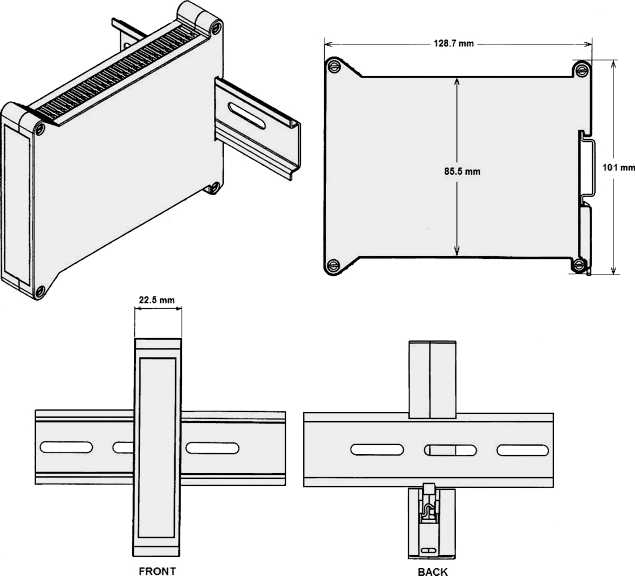
Dimensioned CAD assembly drawings in EPRT, STEP, x_t, .dwg, pdf file formats: Laureate-transmitter-case.zip (zipping prevents browser from opening CAD files as text files).
CLB02
USB-to-RS232 Adapter Cable
CBL04
RS232 Cable for LT Transmitters
What is an LTE DIN Rail Analog Transmitter with Ethernet Communication and Analog Outputs for Thermocouple Temperature?
In the realm of industrial automation and process control, the LTE Series DIN Rail Analog Transmitter stands out as a versatile and essential component, particularly when dealing with thermocouple temperature measurement. This article delves into the features and benefits of this advanced transmitter, highlighting its integration capabilities, communication features, and the advantages it offers for precise temperature monitoring and control.
Understanding the LTE Series DIN Rail Analog Transmitter
1. What is a DIN Rail Analog Transmitter?
A DIN Rail Analog Transmitter is an electronic device designed to convert temperature measurements from a thermocouple into an analog signal, which can then be used by various control systems and instrumentation. The "DIN Rail" designation refers to the standard mounting method on DIN rails, which are widely used for securing electrical components in industrial settings.
2. Key Features of the LTE Series:
-
Thermocouple Compatibility: The LTE Series transmitter is specifically designed to work with thermocouples, which are widely used temperature sensors known for their accuracy and wide temperature range. Thermocouples generate a small voltage proportional to temperature changes, which the transmitter converts into a usable signal.
-
Analog Outputs: The transmitter provides analog outputs, such as 4-20 mA or 0-10 V, which are standard in industrial applications. These outputs can be easily interfaced with data acquisition systems, PLCs (Programmable Logic Controllers), and other control devices.
-
Ethernet Communication: One of the standout features of the LTE Series is its Ethernet communication capability. This allows for seamless integration into modern industrial networks, enabling remote monitoring, configuration, and data logging. Ethernet connectivity supports protocols like TCP/IP, making it compatible with a wide range of industrial systems and software.
-
DIN Rail Mounting: The transmitter's design includes a DIN rail mounting feature, which simplifies installation and maintenance. DIN rail mounting provides a secure and standardized method for attaching the transmitter to an industrial control panel or enclosure.
Benefits of the LTE Series Transmitter
1. Precision and Accuracy:
The LTE Series is engineered to deliver precise temperature measurements by effectively translating the thermocouple's voltage signal into accurate analog outputs. This ensures reliable temperature monitoring, which is crucial for maintaining process quality and safety in industrial applications.
2. Enhanced Communication:
With built-in Ethernet communication, the LTE Series enables advanced data handling capabilities. Users can easily access real-time temperature data, configure transmitter settings, and perform diagnostics remotely. This enhances operational efficiency and allows for proactive maintenance and troubleshooting.
3. Versatile Integration:
The transmitter's analog outputs make it compatible with a wide range of control and monitoring systems. Whether integrating with existing control panels or modern data acquisition systems, the LTE Series provides flexibility in system design and implementation.
4. Ease of Installation:
DIN rail mounting simplifies the physical installation of the transmitter, making it easier to integrate into existing control panels and systems. The standardized mounting system ensures that the transmitter is securely fastened and properly aligned.
Applications
The LTE Series DIN Rail Analog Transmitter is ideal for various industrial applications where precise temperature measurement is critical. Common use cases include:
- Manufacturing: Monitoring and controlling temperature in processes such as metal forging, plastics processing, and chemical reactions.
- HVAC Systems: Ensuring accurate temperature control in heating, ventilation, and air conditioning systems.
- Food and Beverage: Maintaining precise temperatures in cooking, refrigeration, and processing applications to ensure product quality and safety.
Conclusion
The LTE Series DIN Rail Analog Transmitter with Ethernet Communication and Analog Outputs for Thermocouple Temperature represents a powerful tool for modern industrial temperature measurement and control. Its combination of precision, advanced communication capabilities, and ease of integration makes it a valuable component in a wide range of applications. By leveraging the features of the LTE Series, industries can achieve enhanced accuracy, operational efficiency, and flexibility in their temperature monitoring systems.
Understanding the Applications of an LTE Series DIN Rail Analog Transmitter with Ethernet Communication and Analog Outputs for Thermocouple Temperature
In the realm of industrial automation and process control, precision and reliability are paramount. An LTE Series DIN Rail Analog Transmitter with Ethernet Communication and Analog Outputs for Thermocouple Temperature is a sophisticated instrument designed to meet these needs. This article delves into the various applications of this versatile device, illustrating how it enhances temperature measurement and control across different sectors.
What is an LTE Series DIN Rail Analog Transmitter?
Before exploring its applications, it’s essential to understand what an LTE Series DIN Rail Analog Transmitter is. This device is designed to convert the temperature readings from a thermocouple sensor into a standard analog signal, such as 4-20 mA or 0-10 V, which can be easily interpreted by other control systems. Additionally, the transmitter features Ethernet communication capabilities, allowing for seamless integration into modern digital control networks.
Key Applications
-
Industrial Manufacturing:
In industrial manufacturing, precise temperature control is crucial for maintaining product quality and ensuring operational efficiency. The LTE Series transmitter is often used in processes such as metal forging, plastic extrusion, and chemical production. By accurately measuring temperatures through thermocouples and providing real-time data via Ethernet communication, the transmitter helps in monitoring and controlling processes with high precision.
-
Building Automation:
Building automation systems benefit from the LTE Series transmitter’s ability to integrate temperature data into broader control systems. Whether it's for managing HVAC systems, monitoring environmental conditions, or controlling energy use, the analog transmitter provides critical temperature measurements that support efficient building management.
-
Energy Sector:
In the energy sector, temperature monitoring is vital for the operation of equipment such as turbines, generators, and reactors. The LTE Series transmitter ensures accurate temperature readings, which are essential for maintaining safety and optimizing performance. The Ethernet communication capability allows for remote monitoring and diagnostics, enhancing operational oversight and reducing downtime.
-
Food and Beverage Industry:
Temperature control is essential in the food and beverage industry to ensure product safety and quality. The LTE Series transmitter can be used to monitor temperatures in processes such as pasteurization, fermentation, and cooking. By providing accurate and reliable temperature data, it helps in maintaining compliance with regulatory standards and improving process efficiency.
-
Pharmaceutical Manufacturing:
The pharmaceutical industry requires stringent temperature control to ensure the efficacy and safety of products. The LTE Series transmitter’s precision and reliability make it suitable for applications in pharmaceutical manufacturing, where accurate temperature measurement is critical for processes such as drug production and storage.
-
Automotive Industry:
In automotive manufacturing and testing, temperature control plays a significant role in ensuring the performance and safety of vehicles. The LTE Series transmitter is used to monitor temperatures in various automotive systems, including engines, transmissions, and exhaust systems, providing valuable data for quality control and performance testing.
Benefits of LTE Series Transmitters
- High Accuracy: Ensures precise temperature measurement, which is crucial for maintaining the quality and safety of processes.
- Ethernet Communication: Facilitates integration into digital control systems, allowing for remote monitoring and data analysis.
- Versatility: Suitable for a wide range of industries and applications, from industrial manufacturing to building automation.
- Reliable Performance: Built to withstand harsh industrial environments, ensuring consistent performance and longevity.
Conclusion
The LTE Series DIN Rail Analog Transmitter with Ethernet Communication and Analog Outputs for Thermocouple Temperature is a vital tool in modern industrial and commercial applications. Its ability to provide accurate temperature readings, coupled with its advanced communication features, makes it an invaluable asset for various industries. Whether it’s for optimizing manufacturing processes, enhancing building automation, or ensuring compliance in regulated industries, this transmitter delivers the precision and reliability needed to meet today’s demanding operational requirements.
Less Information.

































